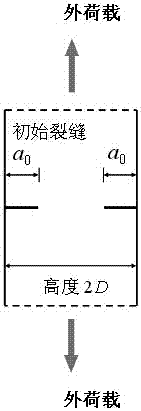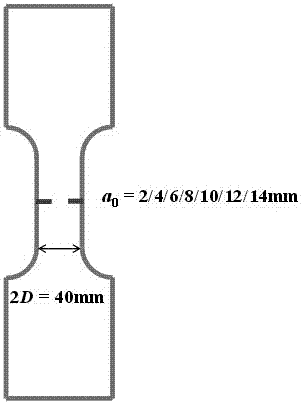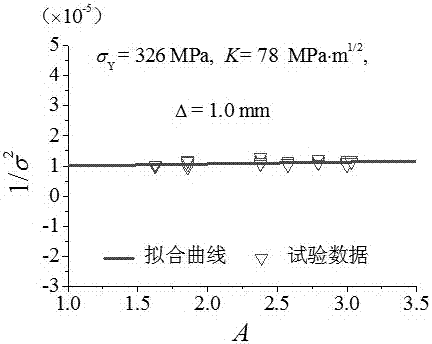Method for determining fracture toughness and strength by using double-cut small-sized specimens
A technology of fracture toughness and small size, which is applied in the direction of using stable tension/pressure to test the strength of materials, etc., can solve the problem that small-size specimens cannot be directly used for evaluation, and achieves easy judgment of the rationality of the results, test operation, good stability
- Summary
- Abstract
- Description
- Claims
- Application Information
AI Technical Summary
Problems solved by technology
Method used
Image
Examples
Embodiment 1
[0049] Hot-rolled carbon steel is used to make double-sided slit tensile specimens, and the specific shape of the specimens can be found in figure 2 , the sample height is 2D=40mm, B=6mm, L=60mm, the height of the sample arc section is 20mm, and the size of the rectangular clamping end is: 70mm×80mm. The obtained samples were cut into cracks by wire cutting process, and the crack width was less than 0.20mm. The slit height ratio of the fabricated sample a 0 / D = 0.1, 0.2, 0.3, 0.4, 0.5, 0.6, 0.7, 5 samples were made for each group of seam height ratio, a total of 7 groups of 35 samples.
[0050] The test was carried out at a constant speed according to the rate specified in the "Metallic Materials Tensile Test Part 1: Room Temperature Test Method" (GB / T 228.1-2010) and other specifications, and the load was continued until the specimen was broken. The yield load of each specimen was recorded during the test.
[0051] see image 3 , determine the fracture toughness K and y...
Embodiment 2
[0055] In this example, cement mortar specimens are used in the test, and the specimen sizes D×B×W are three types, which are 51×19×19mm, 102×19×38mm, 153×19×76mm, and the initial joint height ratio α= a 0 / D=0.3.
[0056] Based on formula (2) and formula (3), the nominal strength σ of each specimen can be calculated from the measured peak load F n , combined with A, brought into formula (1) for regression analysis, the tensile strength and fracture toughness of the cement mortar material can be obtained at the same time.
[0057] For the fracture toughness and tensile strength results of the cement mortar material determined by the regression of the test data of embodiment 2, see Figure 4 , the fracture toughness and tensile strength data of the determined cement mortar materials are shown in Table 2 below.
[0058] Table 2 embodiment 2 determines fracture toughness and tensile strength of cement mortar
[0059] Δ / mm K / MPa·m 1 / 2
[0060] It can be seen that...
Embodiment 3
[0062] In this example, concrete specimens are used in the test, and the specimens have three dimensions D×B×W, which are 51×19×19mm, 102×19×38mm, 153×19×76mm, and the initial joint height ratio α=a 0 / W=0.3.
[0063] Based on formula (2) and formula (3), the nominal strength σ of each specimen can be calculated from the measured peak load F, combined with A, brought into formula (1) for regression analysis, the concrete material can be obtained at the same time fracture toughness and tensile strength.
[0064] The fracture toughness and tensile strength results of the concrete material determined by embodiment 3 test data regression can be found in Figure 5 . The fracture toughness and tensile strength data of the determined concrete are shown in Table 3 below.
[0065] Table 3 embodiment 3 determines the fracture toughness and tensile strength of concrete
[0066] Δ / mm K / MPa·m 1 / 2
[0067] It can be seen that the fracture toughness and tensile strength of ...
PUM
| Property | Measurement | Unit |
|---|---|---|
| Fracture toughness | aaaaa | aaaaa |
| Yield strength | aaaaa | aaaaa |
| Yield strength | aaaaa | aaaaa |
Abstract
Description
Claims
Application Information
 Login to View More
Login to View More - R&D
- Intellectual Property
- Life Sciences
- Materials
- Tech Scout
- Unparalleled Data Quality
- Higher Quality Content
- 60% Fewer Hallucinations
Browse by: Latest US Patents, China's latest patents, Technical Efficacy Thesaurus, Application Domain, Technology Topic, Popular Technical Reports.
© 2025 PatSnap. All rights reserved.Legal|Privacy policy|Modern Slavery Act Transparency Statement|Sitemap|About US| Contact US: help@patsnap.com



